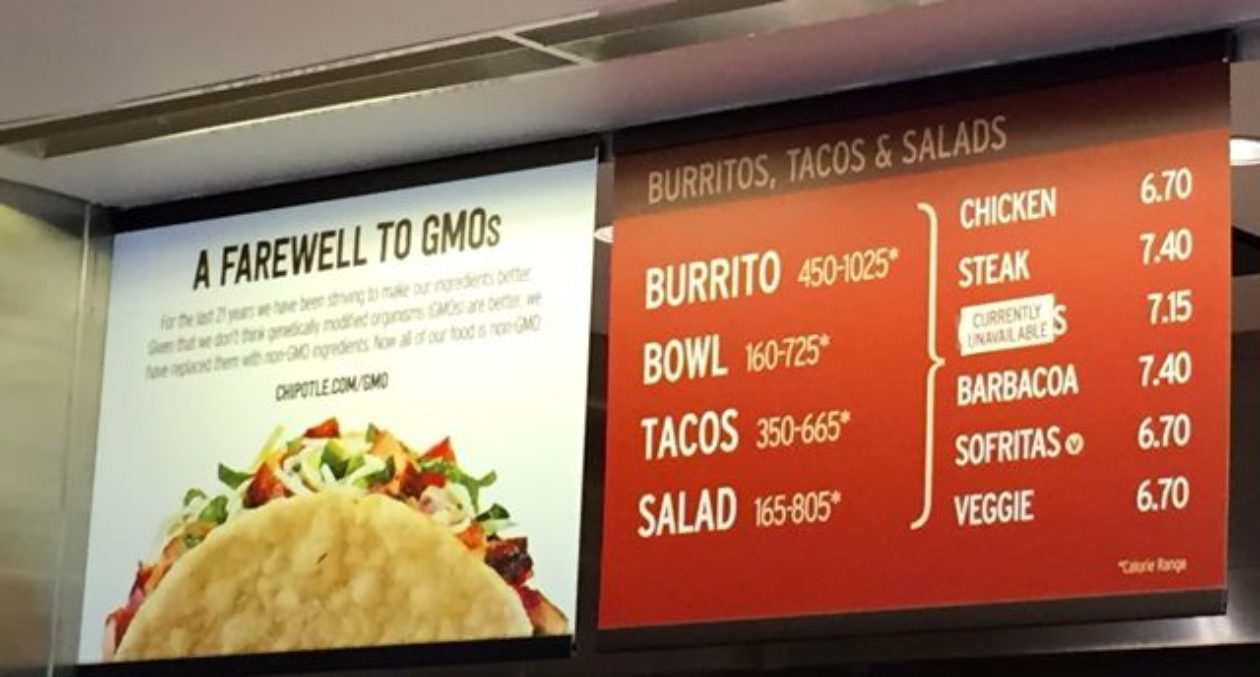Chipotle Removes GMOs to Show It Cares
Bloomberg View , April 30, 2015

Offering customized dishes and generous portions, Chipotle Mexican Grill Inc. has become the new touchstone of American fast-food dining. Everyone from jeans makers to new restaurant concepts wants to be “the Chipotle of” their specialty. Chipotle is the place Hillary Clinton stopped for lunch and where President Barack Obamagot caught reaching over the sneeze guard.
On "The Tonight Show Starring Jimmy Fallon," Jeremy Renner, a.k.a. the Avengers’ Hawkeye, sang a parody about his character’s super powers. One proof that Hawkeye isn’t pathetic compared with Thor or the Hulk: “When I go to Chipotle I get free guac. I flirt with the cashier and she says that I rock.” Everyone, the lyrics assume, goes to Chipotle. So everyone knows that guacamole costs extra.
With 1,831 outlets, Chipotle is far from the largest fast-food chain, but it’s the most culturally salient: a symbol of how Americans eat today. Its decision to this week remove genetically modified ingredientsfrom its menu fits with the strategy that has made Chipotle so successful -- but not because there’s necessarily anything wrong with such ingredients.
If, like me, you consider genetically modified crops a beneficial example of scientific ingenuity, you’re probably tempted to dismiss Chipotle’s decision as nothing more than a sop to anti-technology superstition. “Chipotle is condoning the notion that GMOs are bad, much in the way Whole Foods evangelizes pseudoscience by stocking its shelves with books about herbal medicine and homeopathic remedies,” wrote Slate’s Alison Griswold. Gizmodo’s Sarah Zhangcalled the switch “pandering BS,” and the Washington Post opined that the company had "added its imprimatur to a global propaganda campaign."
In fact, there’s a valid strategic reason for the switch. Customers who believe that GMOs are bad are happy, of course. But even if you don’t care about GMOs, the decision sends a positive signal. It’s a high-profile sign that Chipotle is paying close attention to the ingredients in its food. Replacing GMOs required reworking recipes, finding new suppliers and paying more for canola oil. It demanded concentrated effort. The process reinforces the message that Chipotle isn’t just doing what’s easy or cheap. It reminds customers that the company isn’t delivering generic, mass-market meals -- that Chipotle cares about the food.
Customers get the same message from the pork shortages that have left about a third of Chipotle stores pasting “currently unavailable” over the carnitas option on their menu boards. In January, the company suspended one of its pork suppliers for not meeting itshumane-treatment standards. “Rolling blackouts” of carnitas hurt the company’s first-quarter results, but keeping substandard pork off the menu maintained the strategic focus that has made Chipotle a powerful brand.
Running out of a dish such as carnitas is something that happens in a fine-dining restaurant, where the chef buys what looks good in the market that day. Fast-food joints with standardized menus and industrial supply chains don’t run out of things. They’re about reliability and low prices. Or at least they used to be.
Chipotle’s strategic decision to put food first was revolutionary for a quick-service restaurant. “Our food cost is what runs in a very upscale restaurant,” said Chief Operations Officer Gretchen Selfridge in theoral history compiled by Bloomberg’s Kyle Stock and Venessa Wong. Chipotle’s priorities shocked McDonald’s, which owned part of the company from 1998 to 2006. She recalled, “They’d say, ‘Gosh guys, why are you running 30 percent to 32 percent food costs? That's ridiculous; that's like a steakhouse.’” (Food costs have since hit a whopping 35 percent of sales.)
For Chipotle, buying pork from farms that give pigs more room isn’t simply a matter of animal welfare. The company believes conventionally raised pork just doesn’t taste as good. “The improvement in the carnitas was dramatic once he switched to these small pig farms,” Bob Ells, the father of founder and chief executive officer Steve Ells, recalled in the oral history.
You don’t abandon a successful strategy to avoid a single bad quarter. You make difficult choices for long-term advantage. “To have a strategy, rather than vague aspirations, is to choose one path and eschew others,” writes the management scholar Richard Rumelt in "Good Strategy/Bad Strategy: The Difference and Why It Matters."
The signs telling Chipotle customers that the restaurant has eliminated GMOs and that it is out of carnitas both send the same message: This is a place that goes to great lengths to make sure your food tastes good. Making real strategic choices is how you get to be the Chipotle of contemporary culture.
- Since I am neither a teenage athlete nor a small army, I generally avoid Chipotle, whose enormous portions make it the Cheesecake Factory of fast food. But for research purposes, I dropped by the Westwood Village unit near the University of California at Los Angeles for a chicken-bowl lunch. Sure enough, my meal was twice as big as I would have liked. It was also quite tasty and hard to stop eating, which is why I threw out only about a third of it and left feeling extremely logy.